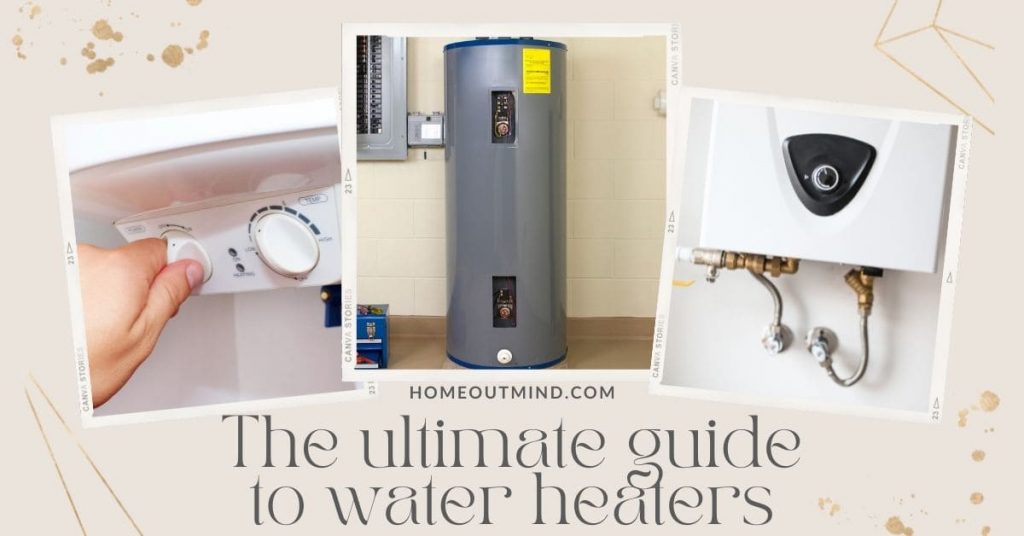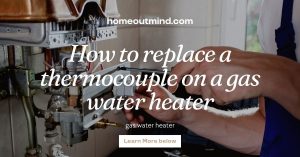Forget shivering under tepid water – conquer your home’s hot water mysteries with this guide! Whether you’re a DIY whiz or a curious homeowner
We’ll unveil the workings of gas, electric, and tankless models, equip you to tackle common issues, and guide you through maintenance and choosing the right replacement. Ready to say goodbye to cold surprises? Let’s dive in!

Understanding Your Water Heater: From Spark to Splash
Cold showers are the stuff of nightmares, but understanding your water heater can turn those dreams into steamy realities. Let’s delve into the different types and their inner workings:
1. Gas Water Heaters:
- Imagine a tiny flame: A pilot light ignites a burner when cold water enters the tank.
- Heat Exchange: Flue gases heat the surrounding water, creating a warm reservoir.
- Thermostat Control: As water cools, the thermostat triggers the burner to reignite, maintaining your desired temperature.
Key Components:
- Pilot Light: The ever-burning flame, a safety feature crucial for ignition.
- Burner: Generates heat to warm the water in the tank.
- Thermostat: The brains of the operation, maintaining water temperature.
- Flue Pipe: Guides combustion gases safely out of your home.
2. Electric Water Heaters:
- Think electric coils: Immersed in the water, they heat it directly through electricity.
- Thermostat Control: Similar to gas models, it regulates heating cycles for consistent temperature.
Key Components:
- Heating Elements: The electric coils responsible for direct water heating.
- Thermostat: Just like in gas models, it ensures your desired temperature remains constant.
- Pressure Relief Valve: A safety feature releasing excess pressure to prevent tank failure.
3. Tankless Water Heaters:
- On-demand heating: Water heats instantaneously as it flows through a heat exchanger, requiring no tank.
- Modulating Burner (Gas) or Electric Coils: Adjust heat output based on water flow for efficient heating.
Key Components:
- Heat Exchanger: Transfers heat from the burner or coils to the flowing water.
- Flow Sensor: Detects water flow and triggers heating for on-demand service.
- Gas Burner (if applicable): Heats water directly in gas models.
- Electric Coils (if applicable): Heat water directly in electric models.
Regular Maintenance is Key:
- Drain and flush the tank annually to remove sediment and improve efficiency (gas and electric tank models).
- Inspect the anode rod (gas and electric tank models) and replace it periodically to prevent tank corrosion.
- Schedule professional inspections for gas models to ensure proper venting and burner safety.
Safety First:
- Never attempt to repair a gas pilot light yourself. Contact a qualified professional.
- Turn off power or gas supply before performing any maintenance.
- Be mindful of hot water temperature, especially with children and sensitive individuals.
Now that you have a basic understanding, conquer your water heater woes with confidence! In the next section, we’ll tackle those common issues that threaten your hot water bliss.
Taming the Troublemakers: A Handy Guide to Troubleshooting Common Water Heater Issues
Cold showers are enough to send shivers down anyone’s spine, but don’t despair! Before calling in the professionals, equip yourself with the knowledge to troubleshoot common water heater woes.
Here’s a breakdown of some frequent culprits and resources to help you restore hot water harmony:
1. Flickering Pilot Light (Gas Models):
- The Culprit: A faulty thermocouple or clogged pilot assembly can disrupt the flame.
- ·Your Weapon:
- Check the thermocouple: Replace it if damaged
- Clean the pilot assembly: Use compressed air to remove dust and debris.
- Inspect the gas line: Ensure there are no leaks or blockages. For complex issues, consult a professional.
- Bonus resource: Learn more about fixing a pilot light here: How to fix a water heater pilot light
2. Lukewarm Showers (All Models):
- The Culprit: Thermostat setting, sediment buildup, or a faulty heating element can be the culprits.
- Your Weapon:
- Adjust the thermostat: Refer to your manual for proper settings and consider raising it slightly if needed.
- Flush the tank: Regular draining and flushing removes sediment that reduces heating efficiency.
- Inspect the heating element: If you suspect a malfunction in electric models, consult a professional for diagnosis and repair.
- Bonus resource: Learn about testing a water heater element here: How to test a water heater element
3. Leaky Tank:
- The Culprit: Cracks, loose fittings, or corrosion can cause leaks.
- Your Weapon:
- Identify the source: Inspect for cracks, loose fittings, or corrosion around the tank, pipes, or valves
- Tighten loose fittings: For minor leaks, this might be enough.
- Seek professional help: Significant leaks or cracks require professional repair or replacement.
- Bonus resource: Get more details on why your water heater might be leaking: Why is the water heater leaking?
4. No Hot Water at All:
- The Culprit: Power or gas supply issues, tripped breakers, or complex internal problems can be at fault.
- Your Weapon:
- Check the power or gas supply: Ensure they are on or open, respectively.
- Reset the breaker: If tripped (electric models), reset it.
- Call a professional: For persistent issues or lack of expertise, it’s best to involve a qualified technician.
Remember: Safety first! When in doubt, always consult a licensed professional for repairs that involve gas lines or complex troubleshooting.
Beyond these common scenarios, you might encounter specific issues with different water heater types:
- Fixing an RV water heater: How to fix RV water heater
- Turning up the temperature in an electric water heater: How to turn up hot water heater electric:
- Lighting a gas water heater safely: How to light a gas water heater
With this knowledge and the linked resources, you’ll be well-equipped to conquer common water heater troubles and keep your showers steamy!
Remember, preventive maintenance is key, so be sure to follow your manufacturer’s guidelines for upkeep and enjoy years of worry-free hot water comfort.
Nurturing the Flame: Maintenance and Upkeep for a Happy Water Heater
Just like your car needs regular tune-ups, your water heater thrives on preventative care.
Taking simple steps can extend its lifespan, optimize performance, and prevent costly surprises down the road. Let’s explore the secrets to maintaining your hot water hero:
1. Flushing and Draining: Your Annual Ritual
Think of sediment buildup as the gremlins clogging your water heater’s pipes. Flushing and draining annually (more often in areas with hard water) removes this gunk, improving efficiency and reducing the risk of overheating and damage. Here’s the lowdown:
- Shut off power/gas and water supply.
- Attach a garden hose to the drain valve and direct it to a drain.
- Open the drain valve and allow the tank to empty completely.
- Close the valve and reconnect the hose.
- Open the cold water inlet valve and flush the tank until clear water runs out.
- Repeat flushing until the water runs clear.
- Close the valve, disconnect the hose, and restore power/gas and water supply.
2. Anode Rod: The Sacrificial Hero
This magical rod attracts corrosion away from your tank, protecting it from rust and leaks. But like any hero, it sacrifices itself over time. Here’s how to keep it in the fight:
- Inspect the anode rod every 2-3 years.
- Replace it when it’s worn down to 6 inches or less.
- Consult a professional for the replacement process, especially for gas models.
3. Maintenance Magic Beyond Flushing:
Here are some additional upkeep tips:
- Check the pressure relief valve annually. Pull the lever and ensure water discharges briefly, then automatically reseals.
- Inspect the temperature and pressure gauge regularly.
- Keep the area around the water heater clear and well-ventilated.
- Follow manufacturer’s specific maintenance recommendations.
4. Extending the Lifespan: Your Water Heater’s Secret Weapon
By implementing these regular care rituals, you can significantly extend your water heater’s lifespan, potentially saving money on replacements and repairs. Remember, a little TLC goes a long way in ensuring years of blissful hot showers!
In the next section, we’ll delve into the world of replacing your water heater. Understanding factors like size, energy efficiency, and fuel type will equip you to make the right choice when the time comes.
Choosing Your Water Heater Champion: Navigating Replacement Like a Pro
Saying goodbye to your trusty water heater is inevitable, but choosing its successor doesn’t have to be a daunting task. By understanding key factors and weighing different options, you can select the perfect hot water champion for your needs. Let’s explore the battleground:
1. Sizing Up Your Needs:
- Consider your household size and hot water usage habits. More people and showers require a larger capacity heater. Consult your manufacturer’s guidelines or a professional for specific recommendations.
- Remember the “first hour rating”: This indicates the amount of hot water available in the first hour, crucial for peak demand periods.
2. Fueling Your Flame: Gas vs. Electric vs. Tankless:
- Gas: Faster heating, lower operating costs, but requires proper venting and professional installation.
- Electric: Cleaner, easier installation, quieter, but slower heating and potentially higher operating costs.
- Tankless: On-demand heating, space-saving, energy-efficient, but higher initial cost and installation complexity.
3. Pros and Cons of Each Contender:
- Gas: Pros: Fast heating, lower running costs. Cons: Requires venting, professional installation.
- Electric: Pros: Cleaner, quieter, easier installation. Cons: Slower heating, potentially higher running costs.
- Tankless: Pros: Energy-efficient, endless hot water, space-saving. Cons: Higher initial cost, complex installation, might not be suitable for high demand scenarios.
4. The Final Round: Seeking Expert Guidance
Choosing the right water heater involves careful consideration of your specific needs, budget, and preferences.
Consulting a qualified plumbing professional ensures you receive expert advice on sizing, fuel type, installation feasibility, and potential rebates or incentives available in your area.
Remember, this decision holds the key to years of worry-free hot water comfort. Don’t hesitate to seek professional help for a winning selection!
With this knowledge, you’re equipped to tackle any water heater challenge, from troubleshooting woes to choosing your next champion.
Stay tuned for our optional “Deep Dive” section, where we’ll delve into complex DIY tasks like element replacements and tankless cleaning.
Remember, knowledge is power, and empowered homeowners enjoy blissful hot showers every time!
How to install hot water heater element
Installing a hot water heater element requires precision and attention to detail. Start by turning off the power and draining the tank partially.
Remove the access panels, disconnect the old element, and install the new one securely. Reconnect the wires and ensure proper alignment to prevent leaks.
For step-by-step instructions and safety tips, refer to our comprehensive guide on How to Install Hot Water Heater Element.
How to clean tankless water heater
Regular cleaning is essential to maintain the efficiency of a tankless water heater. Start by turning off the power and water supply to the unit.
Remove any debris or mineral buildup from the inlet filter and flush the system with vinegar or a descaling solution to remove scale deposits.
Rinse thoroughly and reinstall the filter. For detailed cleaning instructions and maintenance tips, refer to our comprehensive guide on How to Clean a Tankless Water Heater.
How to replace thermocouple on water heater
Replacing a faulty thermocouple is necessary if your water heater’s pilot light won’t stay lit. Start by turning off the gas supply and pilot light.
Remove the old thermocouple from the control valve and install the new one, ensuring it’s securely attached.
Relight the pilot light according to manufacturer instructions. For detailed replacement steps and troubleshooting tips, explore our article on How to Replace a Thermocouple on a Water Heater.
How to replace a thermocouple on a gas water heater
Replacing a faulty thermocouple on a gas water heater is crucial for ensuring proper functionality. Begin by turning off the gas supply and pilot light.
Remove the old thermocouple from the control valve and install the new one securely. Follow manufacturer instructions for relighting the pilot light.
For detailed steps and safety precautions, refer to our comprehensive guide on How to Replace a Thermocouple on a Gas Water Heater.
How to vent a tankless water heater
Proper venting is essential for the safe operation of a tankless water heater. Determine the appropriate venting configuration based on the heater’s specifications and local building codes.
Install vent pipes with the correct size and slope to ensure proper exhaust flow. For detailed instructions and venting guidelines, consult our comprehensive guide on How to Vent a Tankless Water Heater.
How to strap a water heater
Securing a water heater with straps is crucial for earthquake safety and code compliance.
Begin by identifying the appropriate locations for securing the straps to the heater and the wall.
Install the straps securely, ensuring they are tight and properly aligned. For detailed instructions and strapping guidelines, refer to our comprehensive guide on How to Strap a Water Heater.
What size wire for water heater
Determining the correct wire size for a water heater is essential for safety and efficient operation. Factors such as the heater’s voltage, amperage rating, and distance from the electrical panel must be considered.
Consult local building codes and electrical standards to determine the appropriate wire size for your specific installation. For more information and wire sizing guidelines, refer to our comprehensive guide on What Size Wire for Water Heater.
Conclusion: Your Hot Water Hero Awaits!
Congratulations on conquering your journey through the world of water heaters! From deciphering the mysteries of different types to tackling common issues and navigating replacement
you’re now equipped with the knowledge to keep your hot water flowing smoothly. Remember, a well-maintained water heater is a happy water heater (and a happy household!).




